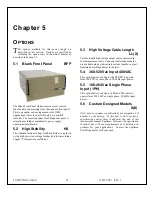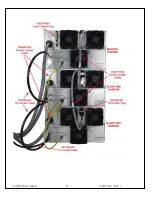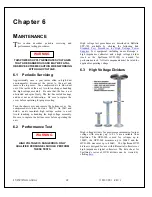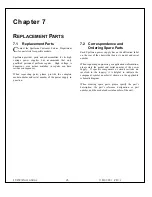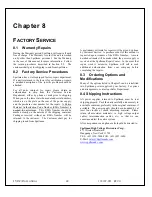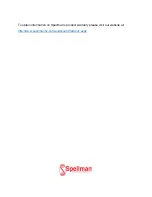
ST/STR/STA MANUAL
17
118107-001 REV J
Chapter 4
Principles of Operation
he ST series of high voltage power supplies utilizes
sophisticated power conversion technology. A variety
of analog, digital and power conversion techniques
are employed. This Principles of Operation will introduce
the basic function blocks that comprise the ST power
supply. For details on a specific circuit, consult
Spellman’s Engineering Department.
The ST power supply is an AC to DC converter. Within
the power supply, conversions of AC to DC, high
frequency AC, then to high voltage DC take place. By
reviewing functionality of the subassemblies, a basic
understanding of the process can be gained.
WARNING
THE ENERGY LEVELS USED AND GENERATED BY
THE POWER SUPPLY CAN BE LETHAL! DO NOT
ATTEMPT TO OPERATE THE POWER SUPPLY
UNLESS THE USER HAS A SUFFICIENT KNOWLEDGE
OF THE DANGERS AND HAZARDS OF WORKING
WITH HIGH VOLTAGE. DO NOT ATTEMPT TO
APPROACH OR TOUCH ANY INTERNAL OR
EXTERNAL CIRCUITS OR COMPONENTS THAT ARE
CONNECTED OR HAVE BEEN CONNECTED TO THE
POWER SUPPLY. BE CERTAIN TO DISCHARGE ANY
STORED ENERGY THAT MAY BE PRESENT BEFORE
AND AFTER THE POWER SUPPLY IS USED.
CONSULT IEEE RECOMMENDED PRACTICES FOR
SAFETY IN HIGH VOLTAGE TESTING #510-1983.
4.1 Line Rectification and
Filtering
WARNING
LINE VOLTAGE IS PRESENT WHENEVER THE
POWER SUPPLY IS CONNECTED TO THE INPUT LINE
VOLTAGE. BE SURE TO DISCONNECT THE LINE
CORD BEFORE OPENING THE UNIT. ALLOW 5
MINUTES FOR INTERNAL CAPACITANCE TO
DISCHARGE BEFORE TOUCHING ANYTHING
CONNECTED TO LINE REFERENCED CIRCUITRY
Simple three phase rectification provides the DC buss
voltage for the high frequency inverter.
An input line cord, three phase circuit breaker (customer
provided on 400Vac Option units), EMI Filter Assembly,
contactor, inrush bridge rectifier, electrolytic capacitors,
rail inductor and rail capacitor comprise the basic
components required for input line rectification.
The standard line input voltage for the ST Series is 180-
264Vac, 50/60Hz. An optional 360-528Vac, 50/60Hz
input voltage is available (400Vac Option). Optional
Single Phase input is available on the STR and STA. If
the user is unsure which input voltage is required, check
the serial tag on the rear of the power supply or consult
Spellman’s Sales Department
The customer provided AC power input is provided to the
unit via the four conductor AC line cord. Circuit
protection is provided by CB1, a fast acting magnetic trip
type circuit breaker. The load side of CB1 is connected to
EMI filter A2. The output of the EMI filter connects to
K1, a three phase contactor. K1 provides fail-safe type
disconnection of the line voltage to the power supply
rectification circuits. K1’s coil is controlled by a variety
of circuit conditions, which will be described later on.
The load side of CB1 is also connected to low voltage
power supply assembly A9, which provides various
voltages for housekeeping and control circuit power.
When contactor K1 is energized, voltage is applied to
isolated bridge rectifier power module CR1, used for line
voltage rectification. The output of CR1 is connected to
aluminum electrolytic capacitors C1 and C2 for line
filtering purposes. Capacitors C1 and C2 are initially
charged through inrush limiting charging resistors which
is located on POWER PWB – A6.
After an appropriate period of time to charge C1 and C2,
relays on POWER PWB – A6 are energized to short out
the inrush limiting resistors. The generated DC buss
voltage is supplied to the inverter circuitry through L2,
L3, L6 and L7. The inductors provide isolation for the
electrolytic capacitors C1 and C2, so the inverter’s high
frequency pulse currents are drawn from the metalized
film high frequency “rail capacitors” C3 and C12.
The POWER PWB – A6 provides the inrush limiting
function via R1, R2, R3 and R4. Relays K1 and K2 short
out the limiting resistors once the initial charging of C1
and C2 is complete. Resistors R7, R8, and R10, R11 form
two feedback divider circuits with terminating resistors
located on the SYSTEM CONTROL PWB – A1. These
impedance limited, low voltage + and – rail feedback
signals are monitored and if any abnormal conditions
appear, circuitry will shutdown the power supply.
T

















